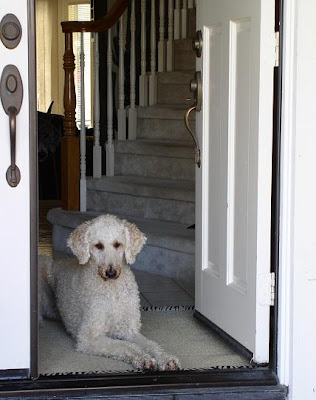
Boundaries; everyone has boundaries, even our dogs do 'or at least they should. After much contemplation I thought that I would tackle this subject today. We've had a lot of work going on at our place this weekend. Lots of trees and bushes coming down and an old fence that was barely standing was finely removed. This fence was a secondary fence; it was basically a marker where our flat yard ended and the slope started. There are still fences between our house and the ones behind us though. It feels very weird and I was extremely curious as to how the dogs would approach this new environment.
The fence that was taken down was only 3 feet but enough to keep the dogs on one side. They were told only a couple of times when they put their feet up there that this was not an option. So even when a cat was on the other side it was well ingrained as a boundary. So when they first saw it gone there was much curiosity; sniffing, backwards leaning just in case something came down and they had to tear off. Luke is the most curious; but only slightly. There is a clear line where the grass ends and the dirt starts that was once behind the fence but is now a part of our yard.
The dogs are not sure if they should check it out; they understand that this was an off limits area. I took a good amount of time yesterday to go out and consider just what we will do with this now fenceless area. Luke was with me and watching me closely as I had a look around. I'd already decided how far I would allow the interest to go as far as the dogs going down the slope. So when he took his first step; ears up and full attention on me although not looking at me he was stopped in his tracks. By watching his body language intently it was clear that he was testing the waters.
The most important boundary for any dog is an exit that could lead to them being injured or killed; like your front door, side gate or garage. It should be very clear that they are never allowed to exit any of these areas on their own. One word and one word alone should allow a dog to cross a boundary. This is one area of training that needs to be very strict; no slack or casual "oh wells." When I train these types of areas as boundaries I do not put a verbal cue on the behavior; it is simply the law. So even if you are not around and a side gate blows open, hopefully your dog will think twice about going through it.
Boundary training is fairly simple; of course depending on your dog and their desire to go through a boundary. By stopping any crossing and rewarding a dog for not following you over a boundary; it is done with baby steps. First the boundary is established; then you work on going over the boundary and not having your dog follow. Treats should be tossed back over the boundary to your dog. Then you work on time spent over the boundary and then the stimulus is added. Pretending a neighbor is talking to you from the street or bouncing a ball on the other side of the boundary etc. Small steps are the way to achieve success and you should receive success at each step before moving to the next. Too large of steps can result in failure; don't set your dog up to fail. You will never regret setting clear boundaries and proofing them.
Learning boundaries leads a student to a clearer comprehension of the boundary itself. This then helps in dealing with the challenge of grasping additional lines in the sand.

I love this post, thank you for posting on this subject! I think too many owners don't bother with boundary training, and sometimes it's lethal.
ReplyDeleteI did want to add something! When doing boundary training, I feel it is extremely important to make sure that your dog or dogs are very well exercised. When dogs are tired, they are more likely to listen and respond, as well as be less likely to want to bolt after something!
Yes; exercise is important, I blogged about that several days ago and will again and again. :)
ReplyDelete